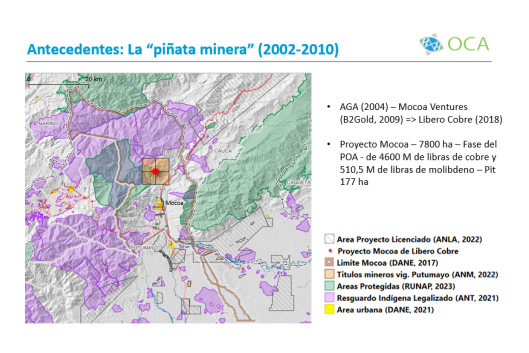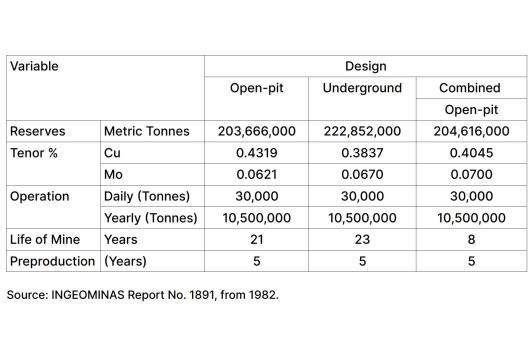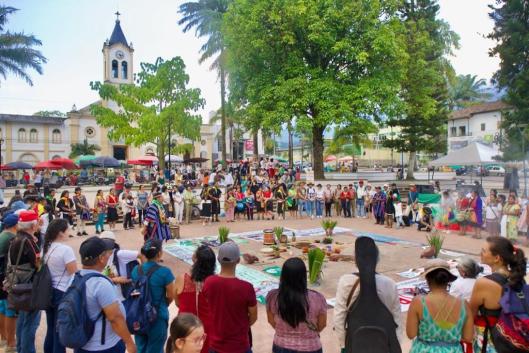The energy transition (ET) is a major challenge for humanity in this century. It is being propelled as the strategy in the face of the climate crisis, global warming, planetary imbalance, and the disappearance of species, etc. Life is at stake, and if the consumption of fossil fuels and mineral derivatives that release CO2—primarily by countries in the Global North and Southern elites—continues, this self-destructive process will be irreversible.
The ET is not new. Throughout history, humans have adopted changes and adapted to improve their wellbeing: striking stones together produced fire, and humans' consumption shifted from raw foods to delicious roasts; there have been advancements in transportation systems—steam, rail, motor and air; and industrialization led to dependence on fossil fuels. In the 20th century, the development of new technologies has implied a progressive increase in the consumption of minerals, including copper.
Colombian president Gustavo Petro has promoted the ET as a duty that all countries should assume—through calls for the reduction in fossil fuel consumption and CO2 emissions. These proposals generate tensions in Colombia with the mining and hydrocarbon sector; it is difficult to abandon this model.
Meanwhile, when talking about ET, little or no mention is made of the numerous community experiences that lead to true energy sovereignty. Such experiences stand in contrast to larger-scale projects underway that involve wind farms and solar panels; these installations require large quantities of copper and rare earth minerals—but because the final energy production process does not release CO2, they are classified as "clean."
In this context, the demand for minerals for the decarbonization of the world has intensified, and the ET has become a threat to the northwestern Amazon Basin, given that this area overlaps with one of the country's copper deposits. Currently, Canadian company Libero Copper (registered in Colombia as Libero Cobre) has four mining titles for lands currently in the process of exploration (image 1, red area). In the collective imagination, the assumption is that this mineral will be exported.
The area where the titles are located is 10 km away from the urban center of Mocoa, capital of the department of Putumayo. Approximately 4,600 million pounds of copper and 511 million pounds of molybdenum are projected to be extracted (1). These titles were acquired during the presidency of Álvaro Uribe (2002 -2010), in the period known as the "mining piñata," in which large tracts of land were sold for the country's mining and oil extraction.

Mocoa: An Andean-Amazonian City
Mocoa is located in the southwestern border of the country, 630 km from Bogotá. The city stands out socio-ecologically as being biocultural, with approximately 63,639 inhabitants representing 16.6% of the total state population. It is ethnically composed of indigenous peoples, Afro-Descendants, peasants and settlers. Territorially, there are five indigenous reservations: Inga Condagua and Yunguillo; Inga-Camëntsa; La Paila Naya; Inga and Koreguaje, and La Florida-Nasa; as well as Siona, Yanacona and Pastos indigenous councils and five Afro-descendent Community Councils.
The territory is an amalgam of cultures where the ancestral is still alive: some families use seeds, fibers and clay to make handicrafts for economic sustenance. Other sources of livelihood in this area include nature tourism, agricultural and livestock production and, in urban areas, the service sector and commerce.
Geographically, Mocoa is located at the confluence of the Massif and the Amazon; this area is one of the country's most important territories in terms of water sources, and is known as the hydrological star (2). Additionally, it shares the Upper Mocoa River Basin Protected Forest Reserve bearing its name (RFPCARM, by its Spanish acronym) with the municipality of San Francisco. It is a strategic ecological reserve, being a corridor that connects several National Natural Parks (NNP) and Environmental Reserves. These include Alto Fragua Indi Wasi NNP, Puracé NNP, Doña Juana-Cascabel Volcanic Complex NNP, Cueva de los Guacharos NNP, Laguna de la Cocha, Galeras Flora and Fauna Sanctuary, La Corota Island Flora Sanctuary, Paway Mariposario Nature Reserve and the Orito Ingi-Ande Medicinal Plant Sanctuary.
Twenty-one water sources—eight rivers and thirteen streams—cross the territory, making up the Mocoa River wetland complex (3). The Mocoa River, in turn, feeds into the Upper Caquetá River Basin, a region of splendid biodiversity and beautiful landscapes that include moorland, terraces and valleys rich in sediment. Its mountains serve as a refuge for species on the road to extinction, such as spectacled black bears, mountain tapirs and jaguars (4). It is also home to the tree species, Elaeagia pastoensis, popularly known as mopa-mopa—from which people extract varnish, a raw material used by artisans in Pasto (Nariño) (5). These species are listed as being vulnerable to extinction, due to habitat loss and other factors.
Being located in the Andean-Amazonian transition zone, Mocoa has special atmospheric conditions. These include a warm, humid climate with annual rainfall exceeding 4,000 millimeters; a geography of high slopes ranging from 600-3200 meters above sea level; and geologically young soils in formation—making this region an active erosion zone.
The Andean-Amazonian territory under threat
Studies on the mining potential in Mocoa have been carried out for more than four decades. In the 1970s, an agreement was signed between the former National Institute of Geological-Mining Research (INGEOMINAS, by its Spanish acronym) and the United Nations. The attached table is the summary of the report on 31 wells that were drilled on the right bank of the Mocoa River.

Considering the high environmental fragility of Mocoa, what is projected in the INGEOMINAS report is worrisome. Ironically, Mocoa's bounties also imply risk. The wetland complex, the young geomorphology of the soil, and the fact that it is located in the transition zone between tectonic plates (which is why it is crossed by geological faults) make this area susceptible to the impacts of climate change.
The Intergovernmental Panel on Climate Change constantly warns about the degradation of the planet, and that the impacts will be more evident in areas of high environmental fragility. We witnessed this on March 31, 2017, when the Mocoa Tragedy was unleashed: a torrential flood inundated 17 neighborhoods, completely destroying five of them. The avalanche left more than 333 people dead, 398 people severely injured and 71 people missing, according to official records (6). However, local people say the numbers were higher. Most of the people living in the destroyed neighborhoods were victims of forced displacement. As is the case all over the world, these migrants are the ones who live on the margins of cities.
A year after the tragedy, in April, the presidents of Community Action Boards (JACs, by their Spanish acronym) from the villages of Pueblo Viejo and Montclar were informed that the Canadian company, B2 Gold, would carry out mining operations and needed a social license. The company urged the community presidents to call community meetings for this purpose. Faced with this threat—and with the memory of the disaster still fresh—on May 5, 2018, the citizens of Mocoa held a large demonstration, accompanying the JAC presidents from the area. We expressed our total rejection of, and disagreement with, the intended exploitation of our mountains. Among other reasons, we rejected this proposal because part of the mining titles overlap with the collective territories Inga of Condagua and Camëntsa of San Francisco Reservations.
As a political response to this mobilization, the Municipal Council approved Agreement 020 of 2018, which reads as follows: "Taking into account [these events], the Municipality of Mocoa must make environmental protection a priority, which explicitly means the prohibition of mining activities...The magnitude of the tragedy should lead the Municipal Government to observe the principles of precaution, prevention, subsidiary rigor and progressiveness."
Corporate mimicry
As mentioned above, the "mining piñata" meant that the subsoil of the territory ended up in the hands of Canadian companies: Mocoa ventures, B2 Gold and even some with names that sound like they have deep connections to the territory, such as Libero Cobre's "Mocoa Project." B2 Gold, which was operating under the subsidiary Mocoa Ventures, failed to obtain the social license to operate. Furthermore, its exploration term expired, so it sold its titles to Libero Copper Corporation, a company that acquired a 100 percent stake of the "Mocoa Project" on May 7, 2018.
For environmental defense organizations and the citizenry, the entry of Libero Cobre meant a greater threat of possible exploitation. Libero Cobre's actions have caused violations and have infringed local regulations—given that they have bypassed the municipal Agreement 020. At the same time, they have fractured the social fabric by co-opting part of the area's population through the offer of employment, using children in company advertising, and causing other impacts. All of this has led institutes such as the Environmental Conflict Observatory (OCA, by its Spanish acronym) a branch of the National University of Colombia and the Amazonian Institute of Scientific Research (SINCHI, by its Spanish acronym) to classify this case as a socio-environmental conflict.
Resistance to extractivism
Social organizations see that the intended exploitation would cause incalculable environmental damage and make life impossible in the territory. As citizens, we have joined together in an alliance called the Guardians of the Andean-Amazon Collective. With the support of NGOs in Bogotá, we have promoted mobilizations, public hearings, and requirements of supervisory bodies and the environmental authority. We have also organized cultural events: the first and second version of the Festival in Defense of the Mountain, Water and Life (2022; 2023).
In closing, it is worth noting that this case of proposed copper extraction in the Colombian Amazon is becoming more visible every day, to the point where we have managed to get it on the agendas of the Ministry of Environment and Sustainable Development, and the Ministry of Mines and Energy. And we are awaiting the establishment of a roundtable which, per a State Council decision, should limit the mining disorder in the country, as well as make the current government's National Development Plan a reality: to organize territory around water! (7)
Constanza del Pilar Carvajal Vargas
Socio-environmental activist and academic
Threads of Life Collective – Andean-Amazonian Guardians
With the collaboration of: Lucia Barbosa Diaz and William Mauricio Rengifo Velasco.
(1) Michel Rowland, Robert Sim and Bruce Davis in: Libero Copper & Gold Corporation. Vancouver, British Columbia, Canada, January 2022. TechnicalReportMocoaCu-MoDepositColombia150618.pdf Accessed in January 2022.
(2) The Magdalena and Cauca Rivers originate in the Massif, and cross the country from south to north to the Atlantic Ocean; the Patía River heads west to the Pacific Ocean; and the Caquetá River in the eastern Amazon crosses the border into Brazil and flows into the Amazon River. The Putumayo River originates in the foothills of Nudo de los Pastos in the municipality of San Francisco, running for approximately 840 km; its waters are the international border between our country and Ecuador and Peru, and it enters Brazil, where it flows into the Amazon River.
(3) POMCA, Mocoa 2022.
(4) International Union for Conservation of Nature (IUCN).
(5) The United Nations Educational, Scientific and Cultural Organization (UNESCO) recognized the “Knowledge and Techniques associated with the Pasto Varnish, Mopa-Mopa” as an Intangible Cultural Heritage of Humanity. December 21, 2020.
(6) Mocoa tragedy: Why was the State condemned? The Administrative Court of Cundinamarca condemned the State for the events of March 2017. Virtual news from July 14, 2022.
(7) National Planning Department. El agua, eje central para hacer de Colombia “una potencia mundial de la vida. March 2023.
